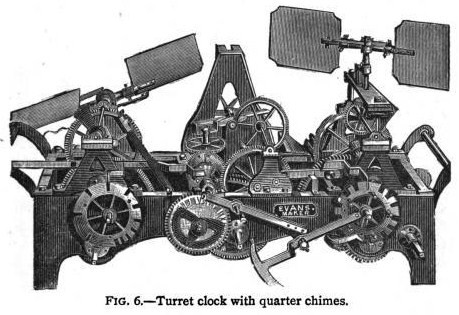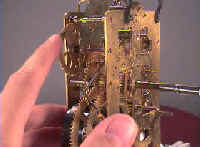The Clock Jobber's Handybook
By Paul N. Hasluck
Brought to you by:
Tick Tock Productions ™
The
CLOCK JOBBER'S HANDYBOOK.
In putting the clock movement together, take especial care to see that the line is free, and on the right side of the pillars. When ready to adjust the line in its place, wind it upon the spring-barrel by turning the arbor ; and when the line is all wound upon the barrel, and the fusee pulled round as far as it will go, set up the main-spring one turn, and secure the click in the ratchet-wheel. Wind the clock up, carefully guiding, the line on the fusee, and see that the slopwork acts properly, and does not cut the line when it rubs. The snail on the fusee should catch against the stop directly the fusee grooves- are filled with the line. Foreign clocks have no fusee, the spring itself being wound round the barrel arbor on which he winding key is placed. The fusee is the distinguishing, characteristic in English spring dials.
French Clocks are of a style of
manufacture different altogether from the English, being distinguished
externally by their elaborate gilt, wood or stone cases, and internally by
finer mechanism, usually set between round plates, with short pendulum
rods and heavy bobs, in proportion to the length. There
are several varieties: timepieces, clocks which strike at the hour and at
the half-hour, carriage clocks, and drum timepieces of various kinds,
besides a large number of curious and fancy styles. They have movements
that are much more delicate and smaller than either English, American or
German clocks; in fact, they almost suggest a grade between clocks and
watches. The circular plates and the short and heavy pendulums usually
distinguish these clocks. Drum timepieces are perhaps the most familiar
specimens of French productions; they are a source of continual trouble to
the repairer. Being extremely portable, they are frequently carried about
the house, often on a tray; and, being very unstable, it is no unusual
occurrence, under such circumstances, to find that the drum timepiece is
rolled down a flight of stairs. The result may be more or less serious:
"a good shake" is the usual remedy. The better kinds of French
clocks give very accurate results, and the striking timepieces are so
delicate and fragile that amateurs should be very chary of them until some
manipulative skill has been acquired. With the exception of the drum
timepieces, French clocks, as a rule, perform uncommonly well, and give
the repairer very little trouble. Vienna regulators, or Austrian clocks,
are of later introduction, very much resemble French workmanship, and are
excellent time-keepers.
German Clocks are made chiefly of wood. Brass bushes are driven into the
wooden frames or plates, to form bearings for the pivots. Familiarly
called Dutch clocks, they are well known, being cheap, and fairly- good
time-keepers. Weights are the motive power, and they hang from the clock,
exposed together with the pendulum; this is a distinguishing feature. Most
German clocks may be easily known from those of any other nationality by
their plates of wood, with brass bushes for the pivots to run in; no other
country produces clocks made in this manner. The manufacture of clocks in
Germany is almost entirely confined to the locality of Black Forest, and
forms there an important branch of industry; nearly every form of ordinary
clock being made, in addition to large numbers of "cuckoo,"
"trumpeter," musical, automaton, and curious clocks. Hall Clocks
are the old-fashioned, long-cased clocks, standing six or seven feet high.
They have pendulums beating seconds, and have weights for the motive
power. When we look from the high standpoint of modern clockwork, in some
instances the workmanship of these old clocks is open to criticism. Still,
the whole machine is the best that has been designed for reliable
time-keeping. The solid construction of all its parts, and the regular
proportions of the wheels — so far as their numbers and revolutions are
concerned — and, above all, the seconds pendulum, and the long fall
given to the weights, combine qualities which, notwithstanding the rude
execution sometimes met with, give better results than any other class of
clocks made for household purposes. Regulators are constructed with every
possible care to ensure the greatest accuracy in time-keeping.
Astronomical observatories, watchmakers' shops, and occasionally the
houses -of private individuals who value extreme accuracy in time, are the
usual repositories for regulators. They generally have pendulums that beat
seconds, and which are compensated for variation in temperature. Mercurial
pendulums are now mostly used when cost is not a great object. Regulators
seldom require any other attention than cleaning very carefully and oiling
properly. On account of the value of the time-keeper and the delicacy of
the mechanism, the inexperienced jobber should not make any essays on
regulators. Skeleton Clocks are frequently found in common use. They are
made with pierced brass plates of ornamental design, and the entire
movement is exposed to view. A glass shade is placed over it to exclude
dust, &c. These clocks are very good time-keepers, and are interesting
inasmuch as they afford the opportunity of examining the mechanism when
going, and thus becoming familiar with its action. A simple eight-day
skeleton clock standing eighteen inches high made for about $25 with
marble stand and glass shade. The whole of the component parts, including
the frames, wheels, pinions, dial and hands may be bought. Amateurs having
a small lathe and a few other tools could fit the parts together: the
resulting clock being a reliable time-keeper and an ornament to the
mantel-shelf.
Turret Clocks are in construction similar to the ordinary kind, but the mechanism is much larger and stronger. They are placed in church towers, town halls and similar positions. In these large clocks the course of examining strictly enjoined as absolutely necessary in all house clocks may generally be dispensed with. The cause of stopping is usually apparent, and by trying the side-shake of the pivots in their holes, it can be readily felt if any new ones are required. The depths are nearly always correct, and the end-shakes can be tried the last thing when put together. The illustration, Fig. 6, shows a turret clock with the maker's name upon it. It chimes all the quarters, strikes hours on a ton bell, and shows time on four dials. It is constructed with the bed of cast-iron, 6 ft. long; all wheels and bushes are of gun-metal, the main wheels are 16 in. diameter and the teeth 1.5 in. wide, the pinions are cut from solid cast-steel, the escapement is Denison's double three-legged gravity. The pendulum compensation of iron and zinc tubes and steel rod, carrying a ball weighing two cwt. The quarters' cam barrel consists of iron rings, into which the cams for lifting the hammers fit, and can be adjusted in any way required. There are many recent improvements in the construction of this clock; all cams and levers are of cast-steel, hardened and tempered. Any wheel or pinion can be taken out of the frames separately, the bushes being screwed in at both ends ; there are over 900 pieces in the clock and dial work. There are two ways of treating church clocks : one consists FIG. 6. — Turret clock with quarter chimes.

of cleaning them as well as possible
with a brush, without removing any of the wheels from the frame, called
" wiping out; " and the other in taking them all to pieces and
thoroughly cleaning, in the same manner as small clocks. Which method is
necessary or desirable must be decided by judgment. It will be found
usually sufficient to thoroughly clean them about every five or six years,
and "wipe them out " once every year — about autumn being the
best time, before the cold weather sets in to influence the oil. When the
clock drives the hands at a distance, it is very necessary to see that the
leading-off rods and universal joints
Learn clock repair with these DVD courses! Course manuals are included.
Watch, study and learn antique clock repair through DVD course instruction using actual live repairs!!
Clock Repair 1 & 2 Advanced Clock Repair PRO advanced clock repair
Clockmaker Watchmaker Lathe Basics Clockmaker Watchmaker Lathe Projects Clock Case Repair & Restoration Wooden Works Movement Repair
© Copyright 2001-2009 by Tick Tock Productions © Copyright 2001-2009 by John Tope All rights reserved.
Back to clock information page.
Hasluck, Paul N. The Clock Jobber’s Handybook. London: Crosby Lockwood and Son, 1889.
This and the following pages are excerpts from the book.
